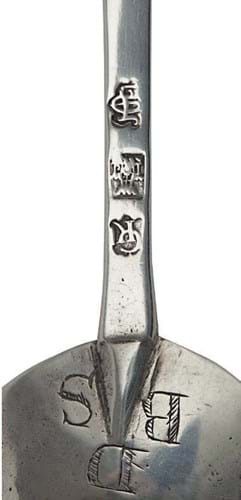The sale of Scottish Works of Art & Whisky at Lyon & Turnbull in Edinburgh on August 12 included a previously unrecorded example from the reign of James VI (James I of England).
It has marks for the maker Gilbert Kirkwood and James Denniestoun, the deacon of the assay office in the years 1613-15 and 1619-21. It is the latter that gives a probable date for hallmarking: prior to 1681 Scottish silver was not struck with a date letter.
Kirkwood, first recorded in the minutes of the Incorporation of Goldsmiths of The City of Edinburgh as an apprentice in 1598, was granted his freedom in 1609. His was seemingly a successful career: he was made deacon himself in 1624 and was sufficiently well-heeled to acquire the Pilrig estate (the house he built in 1638 still stands in suburban Edinburgh).
His mark is recorded on eight pairs of communion cups and various single examples and on the earliest known Scottish slip-top spoon of 1608. The National Museums of Scotland has a disc-end spoon by Kirkwood dated c.1611.
This new discovery, from a little later in the decade, is inscribed to the terminal with the initials SCI and to the rattail bowl with the initials D and BS. Emerging for sale from a Scottish collection, it prompted plenty of interest at its estimate of £3000-5000. The winning bid of £21,000 (plus 25% buyer’s premium) came from a private collector.
More disc-end finds
The price is comparable to the £22,000 bid at the equivalent sale in 2012 for a disc-end spoon, c.1650, marked for Peter Neilson and engraved with the initials of the original owner, Bessy Boyd, the daughter of James Boyd, Archbishop of Glasgow.
More recently a pair of disc-ends with the mark for the deacon George Crawford for 1615-16 or 1621-23 sold as part of the Vogel collection at Sotheby’s New York in January 2019.
This duo, engraved with initials M over HN, appear to be those that had sold for £150 as part of the Sir Andrew Noble collection (dispersed at Christie’s in November 1943) and later sold by How of Edinburgh. Last year, they were surely a bargain at $6000 (£4600).
The only strong comparison to the disc-end spoon outside Scotland is a small group of York spoons known as the ‘death head’ group made between c.1662-78 to mark the christenings of female members of the Strickland family. As they are later in date, it is assumed that these York examples were copied from an earlier Scottish spoon, perhaps one already in the family collection.
















